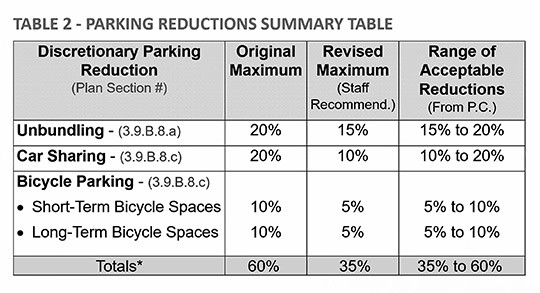VSSP implementation tied to new housing ordinance

by Steven Felschundneff | steven@claremont-courier.com
During yet another grueling and protracted meeting, the Claremont City Council approved the Village South Specific Plan on Tuesday, a crucial step in reshaping the future of the Claremont Village.
The council unanimously approved the VSSP with its long list of guiding principles, design and development guidelines for any construction within the plan area; rezoning the site from business industrial park, commercial highway and commercial professional to the new Specific Plan Area No. 15, Village South Specific Plan; and a general plan amendment adding a new land use designation, Indian Hill/Village South transit-oriented mixed use, including a change to the land use map to show the entirety of the plan area as mixed use.
Last month the council deadlocked on approving the VSSP over the issue of discretionary parking reductions, which would allow builders the option of including fewer parking spaces in development plans under specific conditions. The planning commission tweaked the parking reductions during its most recent meeting, sending the revised document back to council.
Language in the original document allowed for parking reductions of 20 percent for both unbundling and car sharing, plus an additional 10 percent for both long and short term bicycle parking, for a maximum total of up 60 percent. Staff revisions, which became part of the final VSSP, lowered unbundling to 15 percent, car sharing to 10 percent and short and long term bicycle to five percent each, for a total of 40 percent.
Unbundling is the practice of selling residential units and parking spaces separately which provides a financial incentive for buyers to reduce the number of cars they own. The practice encourages residents to find alternative ways to get around—walking, riding a bike or taking public transportation—which is also a key element of transit oriented developments such as the ones that the VSSP would create.
A builder can also receive a substantial parking reduction by implementing a shared parking program where the same spot is used by different entities at different times of the day.
Mayor Pro Tem Jed Leano said he would prefer to see the parking numbers that were in the VSSP originally passed by the planning commission but he was satisfied the compromise language would still achieve the creation of transit oriented developments.
“I support the policy that we actually build a transit oriented development. That we build a project that prioritizes housing people over cars, promotes walkability, uses of bikes, uses of alternate modes of transportation besides vehicles,” he said.
The council also approved the final environmental impact report by a vote of 3-1 with councilmember Corey Calaycay voting no because he felt that the FEIR did not adequately address the potential contamination of soil and ground water from trichloroethylene (TCE), an issue that was of great concern to some local residents.
Councilmember Sal Medina recused himself from the discussion and vote, because his business, Packing House Wines could be impacted by the VSSP, creating a conflict of interest.
Proponents of affordable housing have long advocated for including language in the VSSP that would require a certain percentage of units in each new development be classified as affordable for low and very low income people. The current ordinance allows developers to choose either offering a small percentage of units at below market rates or paying an in lieu fee. In the roughly 10 year since it was passed, no builder has opted to offer the affordable units. The city had planned to update the ordinance this year to ensure that affordable units actually get built.
In response, city staff proposed including language in the VSSP document that would delay its implementation until after the council approves a inclusionary housing ordinance.
This proposed change brought a flurry of opposition from both residents around the VSSP site as well as officials from the development company behind South Village, which will likely be the first applicant under the VSSP.
Residents of south Claremont argue the bulk of Claremont’s affordable housing is already in their neighborhood and the change to the VSSP would mean even more would be constructed. The builder expressed fear that, after waiting years to get the project of the ground, this requirement would create even more delays.
Much of the discussion focused on subsidized affordable housing, which Claremont must plan for under its upcoming housing element update as part of the Regional Housing Needs Assessment. However, Principal Planner Chris Veirs told the COURIER that a different type of “affordable” unit could very well be the salve for Claremont’s housing woes.
He described the increased density, with some five-story buildings that include both for sale and rental apartments in the 1,000-foot range that would be financially approachable by a large proportion of people who may have good incomes but still cannot afford a median single family home in Claremont, which is currently $803,000. These homes may rent for about $2,000 per month, compared with a more than $4,000 per month mortgage on the entry level single family residence.
“[The VSSP] creates a vibrant new neighborhood in Claremont that will provide a new kind of housing that Claremont has never provided. And in the case of new apartments, [the city] has not built in 50 years,” Mr. Veirs said.
Mayor Pro Tem Leano asked city staff how quickly the ordinance could be updated and if it were true that the planning commission would be taking the issue up at its next meeting in just a few days, which was confirmed. But he bristled at the notion that the plan should provide adequate room for cars and not for lower income people.
“Several people voiced concern that we were not providing enough housing for cars and in three weeks we fixed that. We fixed it fast,” Mayor Pro Tem Leano said. “Housing advocates have been calling for affordability in this project since last year…I am not okay with the scenario in which housing of cars is raised as a problem, we turn it around and fix it in three weeks but we are hearing about affordability for over a year and we know that a potential adjustment to our ordinance is on the horizon…but we can’t go to September to see if we can get an inclusionary housing ordinance amendment? We gave cars three weeks, let’s give people a little bit more than two months.”
After staff presentations, public comment and extended deliberation, the city council elected to delay the adoption date of the Village South Specific Plan until October 29, which would give the council until September 28 to hammer out a new inclusionary housing ordinance, plus 30 days to an implementation date mandated by state law.









0 Comments